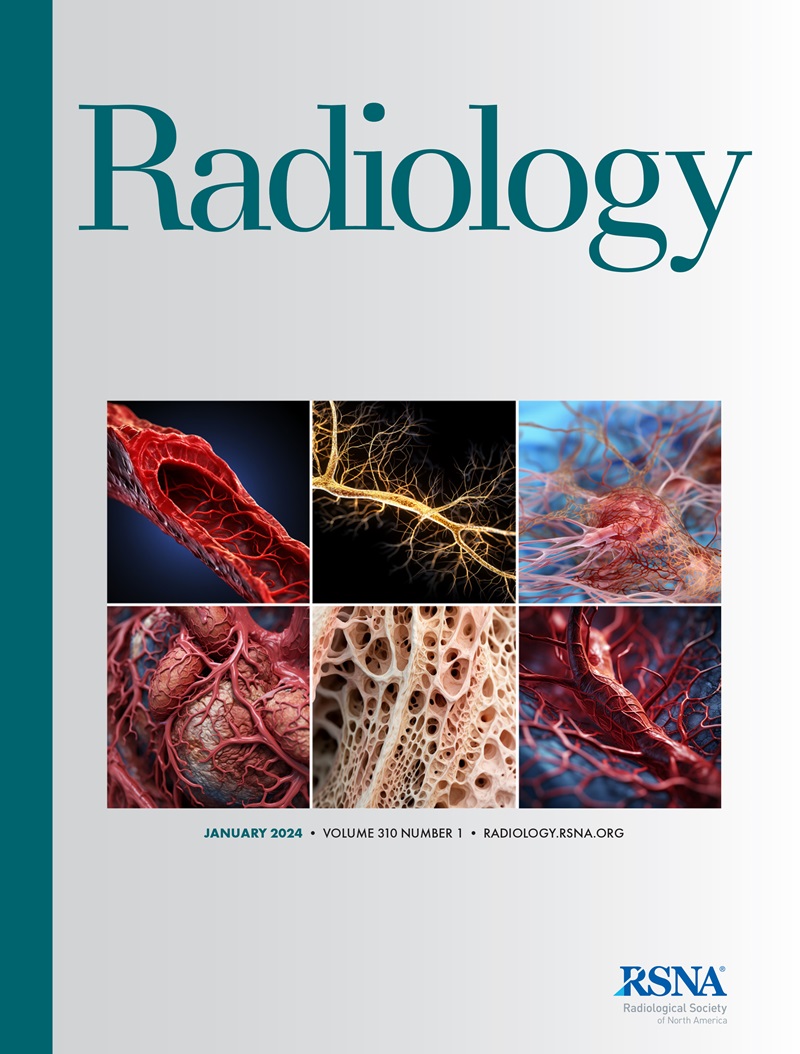Kun Zhang, Kan He, Lei Zhang, Wen-Cui Li, Shuang-Shuang Xie, Ying-Zhu Cui, Li-Ying Lin, Zhi-Wei Shen, Shuang Xia, Xiao-Min Su, Hui-Mao Zhang, Zhao-Xiang Ye, Wen Shen
求助PDF
{"title":"Gadoxetic Acid-enhanced MRI Scoring Model to Predict Pathologic Features of Hepatocellular Carcinoma.","authors":"Kun Zhang, Kan He, Lei Zhang, Wen-Cui Li, Shuang-Shuang Xie, Ying-Zhu Cui, Li-Ying Lin, Zhi-Wei Shen, Shuang Xia, Xiao-Min Su, Hui-Mao Zhang, Zhao-Xiang Ye, Wen Shen","doi":"10.1148/radiol.233229","DOIUrl":null,"url":null,"abstract":"<p><p>Background Prediction of high-risk pathologic features such as microvascular invasion (MVI), poorly differentiated pathologic grade (poor PG), and satellite nodules (SNs) has significant clinical value, as these features are associated with early recurrence and metastasis in hepatocellular carcinoma (HCC). Purpose To develop and validate a preoperative scoring model using gadoxetic acid-enhanced MRI features for noninvasive prediction of HCC high-risk pathologic features and early recurrence. Materials and Methods This retrospective study included consecutive patients with HCC who underwent preoperative gadoxetic acid-enhanced MRI at three centers (one training dataset and two external validation datasets) between January 2014 and January 2021. The preoperative imaging characteristics of each patient were evaluated via multivariable logistic regression, using surgical specimen pathologic evaluation as the reference standard, for prediction of MVI, poor PG, and SNs. In the training dataset, eight intratumoral features, three peritumoral features, and three laboratory indicators were initially evaluated. A scoring model was developed based on the results of the logistic regression, with the following imaging features demonstrating significant independent association with high-risk pathologic features: diameter greater than 4.0 cm, irregular morphology, intratumoral arteries, peritumoral enhancement in the arterial phase, and low peritumoral signal intensity. The resulting score, called the Image score (I-score), to predict early recurrence of HCC in patients was further validated in an outcome dataset. Results A total of 366 patients (median age, 57 years [IQR, 49-64 years]; 314 men, 52 women) from the three centers were included in the training dataset (<i>n</i> = 150), two external validation datasets (<i>n</i> = 73 and 56), and outcome dataset (<i>n</i> = 87). The area under the receiver operating characteristic curve (AUC) of the I-score for predicting high-risk pathologic features was 0.93 (95% CI: 0.88, 0.97) in the training dataset and 0.86 (95% CI: 0.76, 0.93) and 0.84 (95% CI: 0.72, 0.92) in the two external datasets. In the outcome dataset, the I-score was an independent predictor of early recurrence (hazard ratio, 5.2 [95% CI: 1.9, 14.2]; <i>P</i> = .002). A combined model including the I-score and two other predictors demonstrated superior prognostic performance (C index, 0.84 [95% CI: 0.74, 0.91]). Conclusion The developed scoring model based on gadoxetic acid-enhanced MRI enabled noninvasive preoperative prediction of HCC high-risk pathologic features and early recurrence. © RSNA, 2025 <i>Supplemental material is available for this article.</i></p>","PeriodicalId":20896,"journal":{"name":"Radiology","volume":"314 2","pages":"e233229"},"PeriodicalIF":12.1000,"publicationDate":"2025-02-01","publicationTypes":"Journal Article","fieldsOfStudy":null,"isOpenAccess":false,"openAccessPdf":"","citationCount":"0","resultStr":null,"platform":"Semanticscholar","paperid":null,"PeriodicalName":"Radiology","FirstCategoryId":"3","ListUrlMain":"https://doi.org/10.1148/radiol.233229","RegionNum":1,"RegionCategory":"医学","ArticlePicture":[],"TitleCN":null,"AbstractTextCN":null,"PMCID":null,"EPubDate":"","PubModel":"","JCR":"Q1","JCRName":"RADIOLOGY, NUCLEAR MEDICINE & MEDICAL IMAGING","Score":null,"Total":0}
引用次数: 0
引用
批量引用
Abstract
Background Prediction of high-risk pathologic features such as microvascular invasion (MVI), poorly differentiated pathologic grade (poor PG), and satellite nodules (SNs) has significant clinical value, as these features are associated with early recurrence and metastasis in hepatocellular carcinoma (HCC). Purpose To develop and validate a preoperative scoring model using gadoxetic acid-enhanced MRI features for noninvasive prediction of HCC high-risk pathologic features and early recurrence. Materials and Methods This retrospective study included consecutive patients with HCC who underwent preoperative gadoxetic acid-enhanced MRI at three centers (one training dataset and two external validation datasets) between January 2014 and January 2021. The preoperative imaging characteristics of each patient were evaluated via multivariable logistic regression, using surgical specimen pathologic evaluation as the reference standard, for prediction of MVI, poor PG, and SNs. In the training dataset, eight intratumoral features, three peritumoral features, and three laboratory indicators were initially evaluated. A scoring model was developed based on the results of the logistic regression, with the following imaging features demonstrating significant independent association with high-risk pathologic features: diameter greater than 4.0 cm, irregular morphology, intratumoral arteries, peritumoral enhancement in the arterial phase, and low peritumoral signal intensity. The resulting score, called the Image score (I-score), to predict early recurrence of HCC in patients was further validated in an outcome dataset. Results A total of 366 patients (median age, 57 years [IQR, 49-64 years]; 314 men, 52 women) from the three centers were included in the training dataset (n = 150), two external validation datasets (n = 73 and 56), and outcome dataset (n = 87). The area under the receiver operating characteristic curve (AUC) of the I-score for predicting high-risk pathologic features was 0.93 (95% CI: 0.88, 0.97) in the training dataset and 0.86 (95% CI: 0.76, 0.93) and 0.84 (95% CI: 0.72, 0.92) in the two external datasets. In the outcome dataset, the I-score was an independent predictor of early recurrence (hazard ratio, 5.2 [95% CI: 1.9, 14.2]; P = .002). A combined model including the I-score and two other predictors demonstrated superior prognostic performance (C index, 0.84 [95% CI: 0.74, 0.91]). Conclusion The developed scoring model based on gadoxetic acid-enhanced MRI enabled noninvasive preoperative prediction of HCC high-risk pathologic features and early recurrence. © RSNA, 2025 Supplemental material is available for this article.

 求助内容:
求助内容: 应助结果提醒方式:
应助结果提醒方式:


